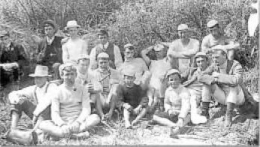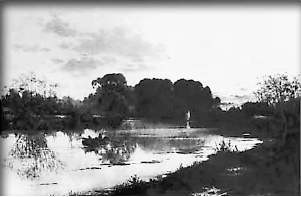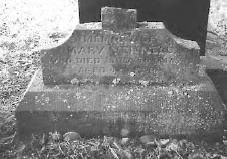George Vennell and other Avon personalities
 Rowing men at Herring Bay, New Brighton about 1900. The man at front left is the painter, Owen Merton
Rowing men at Herring Bay, New Brighton about 1900. The man at front left is the painter, Owen Merton
In the 1890s, old rowing men, among them the luminaries Augustus Blakiston, Richard Harman and Archdeacon Edward Atherton Lingard, came down the Avon and passed the spot where Bickerton Street nears Porritt Park. Called “Wainoni” or “Bickerton’s” and the property of popular unorthodox academic Alexander William Bickerton, the land had, in the 1870s, “humped up into a series of low shifting sandhills, barren except for a few hardy native plants” and a lonely cottage. The area had then been known as “Vennell’s” after a minor riverside denizen, George Vennell, a gardener, whose mysterious fate had attracted national media attention.
Many characters had dwelt along the Avon and there were stories to tell apart from that of the missing gardener. Some of the rivermen recalled how capitalists’ attempts to bring trading vessels up to Christchurch were frustrated by the presence of sandbars and shoals in the lower reaches of the waterway. In 1859 these oldsters accompanied contractors McGrath and Brady to New Brighton where mushrooms “grew thickly adjacent to the river banks right up to the niggerheads, and the swamps round about were smothered with wild ducks”. The beach was strewn with whalebone and timber, the latter having been washed down from the mills further north. The contract men sold these items, the bone long serving as bowers and other decorations in residences within and about the city. Too late, the men discovered that the fish which the gulls were devouring on the beach were frost-fish, a delicacy.
 The Avon at New Brighton showing the original course of the river and the 1859 ’cut’
The Avon at New Brighton showing the original course of the river and the 1859 ’cut’
Press, 20 February 1976
Although a new channel was cut and the course of the river diverted, there was an insufficient depth of water in the Avon for the merchants’ dream of tall ships coming up the waterway to be realised. However, boating men delighted in a clear run from the site of the Seaview Road bridge. Later, youngsters would swim and seek whitebait and frogs in the willow-fringed original watercourse and wild ducks were shot on “Withell’s Island”, the flax-covered property between the channels. Eventually a horse tramway would cart huge sandhills from the lower end of Oram Avenue and fill in the old watercourse.
Many oarsmen recalled purchasing fresh milk, eggs and butter at Kerrs Reach, sitting under the trees, smoking, and chatting with Peter Kerr. After the genial Scotsman’s death in 1877, his widow, Margaret, a “fairly big woman with a warm and generous heart”, carried on the tradition of hospitality.
Further down, John Paynton’s tiny dwelling had a wine and beer licence. A “rustic… house covered with ivy” and commonly termed the “Old Brown Cow”, the place had two whalebones arched as an entrance and, on either side, a holly fence. Wayfarers consumed strawberries and cream and drank wine or “a long draught of nut brown ale” served “in a homely style”. When the licence was moved to the old Bower Hotel site, Thomas Free’s establishment continued with the strawberries and cream menu, adding whitebait teas and “a tot of… rum straight from the barrel and well over-proof”. The hostelry was so popular with the rowing fraternity that it survived in 1894, the year that there was a general reduction in the number of liquor licences.
 ‘Eventide’:photo of an 1888 John Gibb painting of the river at Burwood.
‘Eventide’:photo of an 1888 John Gibb painting of the river at Burwood.
Original owned by the Parochial District of Burwood
The Dallington bridge, built in the 1880s, was testament to the abortive venture of H J C Jekyll and H P Hill to span the Avon and establish a tramway route to New Brighton. Years before, “Broome Farm” had stretched from the site of McBratney’s Road back to that of the bridge. An avenue of eucalyptus led to the house from the direction of Dudley Creek, and the garden and orchard were celebrated in Christchurch. At “Broome Farm” dwelt Avonside Anglican stalwarts Ellen and John Dudley, the latter “a fine specimen of the old colonist who brought out his family, library, plate etc”. After John’s death in 1861, Ellen married schoolteacher William De Troy, and, to the boating fraternity, the place became “De Troy’s”. The family welcomed all oarsmen, the ladies tipping a bucket of cherries into each boat and giving a send-off “so charming that De Troy’s was a delightful break - one of many - that enhanced the trip down”. In June 1867, Ellen’s daughter, Emily Maria Dudley, a young woman whose “face and figure were well known on the Avon”, married grim North Island soldier-magistrate Reginald Newton Biggs. Seventeen months later the couple and their infant son were killed by the “dusky fiend”, Te Kooti, in a pre-emptive strike at Matawhero near Gisborne. William De Troy eventually became clerk to the Ashley Road Board. He, his wife and their daughter, Lucy, died “under particularly sad circumstances” but of natural causes within a few weeks of one another, in 1894.
However, always, when the boating veterans reached the spot near Kerr’s, where George Vennell had lived, their minds were concentrated on his fate.
George Vennell, a ploughman from Whitcombe, Dorset, was five feet four inches in height, had a large head, red hair and eyebrows, low forehead, fair complexion and hazel eyes. In youth he was convicted for theft, whipped and imprisoned. On 22 October 1838, at the age of 20, he was tried at the Somerset Quarter Sessions for stealing clothing and sentenced to be transported for 15 years. His ship, the Marquis of Hastings, arrived in Tasmania on 18 July 1839. George’s colonial crimes ranged from absconding to “being in a public house on Sunday” to “ill-using and causing the death of a calf, the property of his master”. He was incarcerated, put in a hard labour gang and subject to solitary confinement.
On 28 August 1854, in the District of Morven, George Vennell married Mary Scollan. The groom, claiming to be 33, was in fact a little older; Mary was 22. More than a decade later, the couple moved to Christchurch. George, clad in corduroy trousers, faded pea-jacket and black billycock hat, was by now stout, grey-haired and addicted to alcohol. Despite his fondness for drink, his contemporaries considered him “an honest hard-working man in moderately good circumstances”. On 30 July 1871, however, George’s “beloved” Mary died of cancer at Haast Street, Avonside.
Even while Mary lay dying, George was in contact with the woman who would become his second wife. Maria Thompson had led a chequered career. As Maria Drake, she stood in the dock at the Central Criminal Court, London, on 28 November 1842. A native of Bury St Edmunds, Suffolk, a dressmaker and milliner, and five feet three inches in height, she had a fair complexion, brown hair, hazel eyes, long thin nose and wide mouth. Convicted for stealing a watch and watch stand, she was sentenced to transportation for seven years and, on 19 July 1843, reached Tasmania on the Margaret. Fifteen years later and now called Maria Thompson, she appeared on the capital charge of “feloniously, unlawfully and maliciously” leaving a parcel of arsenic-laced custard and cake outside another woman’s door. Oliver Adams and Mary Ann Paul, people unknown to Maria, partook of the food and fell violently ill. The judge “finding the Court of Requests Room most inconveniently crowded, adjourned to the Supreme Court below”. There he took the guilty verdict and condemned Maria to death. The sentence was commuted to penal servitude for life.
Discharged from prison on 8 July 1871, Maria came immediately to Christchurch in the company of her daughter, Hannah; her son, Francis or Frank Sanderson, followed shortly thereafter. In an “Intention to marry” file, George described himself as a gardener of 51 who had been four years in the city; Maria stated that she was a widow, a servant and aged 52 years. On 31 January 1872, at St Luke’s church, George wed the grandiloquently named Henrietta Maria Patience Lydia Sanderson Thompson.
Hannah, Maria’s daughter, married Richard Leaver, the son of a prominent tailor (also Richard) in 1873, and Frank Sanderson also married. Maria and George lived in a rented cottage on an isolated spot on the sandhills. Sometimes, George’s increasing love of the bottle proved embarrassing, especially when, while trying to draw water, he fell into the river and needed vigilant neighbours to rescue him. In 1879, Maria decamped, moving closer to the city and living with her children. In the magistrate’s court the claim was made that, in an attempt to frame George, Maria, Hannah and Richard Leaver had stripped his cottage of its furniture and planted stolen garments.
In August 1879, George’s neighbours, concerned that the blinds were drawn and that the old man had been missing for a week, called the police. When officers arrived, they immediately suspected foul play. A meal had been prepared but not eaten. Somebody had fired bullets through the window and peppered the wall opposite. There was blood on the wall, furniture and brown paper which had attached itself to a gorse fence. Evidence showed that George’s body had been dragged through the garden hedge, a post and rail fence and laid on a sandhill. On the sandhill there was found blood which had oozed from a head wound.
Policemen dragged the river, pushed holes into the mud and dived into the waters, recovering scraps of a blood-stained blanket. However, they were quickly forced out by the intense cold.
Newspaper correspondents pointed out that the police did not have the resources to scour the large area of open and broken ground adjacent to Vennell’s. Moreover, the citizenry showed scant interest in this “most cowardly and cold-blooded murder” which had been committed on its doorstep. When there had been similar outrages elsewhere, even “in districts difficult and dangerous to explore”, people had turned out en masse. In this case they did not do so.
Even so, some responded to police calls for help. Others volunteered when publicans provided transport to and food at the sandhills. One group obtained refreshments from hotelkeepers and storekeepers on the pretext that they had been sent by the police. The greatest inducements to a lethargic populace were those offered by the police - £100 for the recovery of George’s body, £250 for information leading to a conviction.
George’s fellow riverside dwellers were scrutinised as potential suspects. It was thought that money might have motivated one, “Vaughn”. This was probably Edward Vaughn who later dwelt in a snug scrub-surrounded camp on the south bank of the Avon opposite Hardy Street, and, with mock-aristocratic hauteur, styled his German companion, “Frank”, as “my man”. Another neighbour, John Lilly, was eliminated as a “poor feeble creature” who cared for “nothing beyond a pint of beer”.
However, within a short time, the police viewed this as a domestic crime. They noted that Maria had returned to the property and washed the floor, commenting: “You know I could never live in dirt”. Aware that Frank Sanderson hated his step-father, they became convinced that he had committed the murder. Frank, a cook, with dark hair, blue eyes, large nose and sallow complexion, was kept under surveillance and, on one occasion, briefly imprisoned for wife desertion. Some family members who felt themselves tainted by the scandal returned to Australia; certainly Richard Leaver junior was living there at the time of his father’s death in 1911. The fate of Frank Sanderson and his mother is unknown but it is clear that they were never charged with George’s murder.
When, in 1887 and 1892, human remains were found in the sandhills, the subject of George Vennell’s disappearance again came to public attention. Ex-policeman and asylum warden Edward William Seager, muddied the waters. As imaginative as his granddaughter, the novelist Ngaio Marsh, he stated that the bones were those of Captain Cook’s doctor who, it was supposed, had been buried at Pegasus Bay. Museum curator F W Hutton placed this hypothesis before Dunedin bibliophile and historian T M Hocken. Examination of east-of-Christchurch human tissue showed that it belonged neither to the murdered man nor to the spectacled skeleton of Seager’s fancy, but rather, was evidence of an ancient Maori presence in the area.

Mary Vennell's grave, Avonside parish churchyard
Those aware of the Vennell drama can find a memento when, on “an early summer morning [with] a gentle warm breeze just perceptible”, they visit “the most English-looking God’s Acre in Canterbury”, Avonside churchyard. Near the entrance, to the left of the lych-gate, a small plain cross bears the name of Mary, the first Mrs Vennell.
In 1895, an oarsman commented that the £250 reward was still available. As late as 1980, nonagenarian Reg Bellamy stated that, in childhood, he and his friends were sent from New Brighton to Wainoni to search for Vennell’s remains. The reward money long remained in the public consciousness but it has never been claimed.
Sources
- Brighton standard, Vol 1, No 19, 8 January 1937
- Burdon, R M. Scholar errant (1956)
- Burke manuscript. Christchurch City Libraries’ archives
- Caldwell, Graham. Early Dallington (1991)
- Church register transcripts of baptisms, marriages and burials, Aotearoa New Zealand Centre, Christchurch City Libraries
- Convict records, Tasmanian State Archives: copies of relevant items supplied by Dianne Snowden
- Greenaway, Richard L N. Burwood, All Saints’ church, 1877 1977 (1977)
- Greenaway, Richard. Interviews in the 1970s with Nina Slater, Keith Marriott and Reginald Bellamy
- Greenaway, Richard L N. “Taming the Avon”, Press, 29 February 1976
- Hampton, Denis. Headstone transcripts, Holy Trinity churchyard, Avonside (1979)
- Hobart town daily mercury, 30 July 1858: copy of Maria Thompson’s trial for attempted murder supplied by Dianne Snowden
- Hocken, T M. Personal letters and documents, Hocken Library, University of Otago, Dunedin
- “Hotels”: Information file, Aotearoa New Zealand Centre, Christchurch City Libraries
- “Intention to marry” files, Archives New Zealand, Wellington
- Lamb, R C. From the banks of the Avon (1981)
- Lyttelton times, 25 August 1879
- Macdonald, G R. Macdonald dictionary of Canterbury biographies, Canterbury Museum Documentary History Department
- New Zealand police gazette, 27 August, 10 September, 24 September 1879
- Norman, E J. History of the Avonside parish district. MA thesis, Canterbury University College (1951)
- Police Department, Christchurch. Archives, Archives New Zealand, Christchurch
- Press, 1 August 1871, 3 November 1887, 4 November 1887
- Star, 28 February 1879, 15 August 1879, 23 August 1879, 25 August 1879, 27 August 1879, 30 August 1879, 10 June 1892, 16 December 1893, 29 September 1894, 5 February 1895, 29 August 1903, 31 May 1919
- Weekly press, 1 January 1913


 Discover your family’s history at our libraries
Discover your family’s history at our libraries